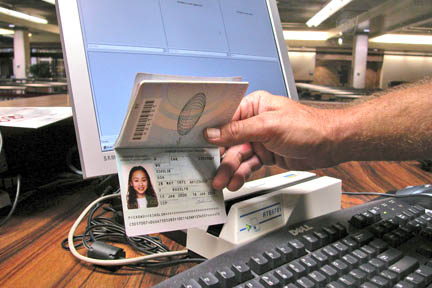

|
Customs policy could
cause more delay
for visitors
New customs procedures that begin this week have tourism officials worried that international visitors, particularly the Japanese, will pack up and go elsewhere rather than wait in line to get into Hawaii.
Honolulu Airport already has the fourth-longest wait times for international visitors -- 52 minutes from plane to curb, according to U.S. Customs and Border Protection.
Those wait times will likely increase starting Thursday when the Department of Homeland Security begins requiring that all international visitors be photographed and fingerprinted upon arrival in the country. Visitors from Canada are exempted.
The change means that customs agents in Honolulu will go from processing about 600 visitors a day to about 4,250 -- an increase of more than 600 percent. Wait times to conclude the procedures are estimated to grow to an average of an hour or longer from about 45 minutes, according to U.S. Customs and Border Protection.
The potential for longer lines to clear customs is spooking the visitor industry.
International travelers who view the entry procedures as inconvenient or unpleasant could choose to visit other destinations closer to home, said Gilbert Kimura, spokesman for Japan Airlines.
"Asia and China have really opened up to visitors, and if Japan travelers feel the process is too humbug, I imagine that they would just as soon go to these other destinations," Kimura said.
The state's economy depends on these arrivals, state tourism liaison Marsha Wienert said.
While the state's domestic visitor market is its strongest by far, international visitors often come during the off season and spend more than their U.S. counterparts, she said.
Currently, only visitors who need a visa to enter the country must pass the more stringent checks designed to weed out terrorists, criminals and those likely to overstay their visas. When the process was first implemented in January, international visitors arriving in Honolulu reported delays as long as two and three hours, but after complaints, most of the kinks were worked out.
Australians Jenni and Sam Damato and their three children went through customs in about 30 minutes, they said Friday.
"It was harder to get out of Australia," Jenni Damato said. "They were super-efficient and we got through easily. We had thought it was going to be really hard."

|
But under the expanded program, all international visitors -- including those from Japan, Hawaii's biggest international visitor market -- will face additional scrutiny.
Most destinations will be able to process travelers within 40 minutes, according to customs. But wait times at Honolulu will likely be far longer because the bulk of international travelers arrive daily between 7 and 11 a.m. from Japan, said Jeff Sawyer, primary branch chief of customs in Hawaii.
"Approximately 85 percent of our morning passengers are visitors requiring 60 to 90 seconds to be processed," he said.
Federal and state officials have been working for months on a solution and have made several accommodations designed to move visitors through customs faster and make their wait more pleasurable, Wienert said.
"It concerns us when we see what the wait times are already and we know that they could escalate dramatically when we have to bring additional people through," Wienert said.
The state is opening two lounges so that visitors will not have to stand in line longer than 30 minutes and to give them access to bathrooms, she said.
Plans also include staffing all 52 customs entry booths and, as a last resort, asking airlines to stagger flights, Wienert said.
Few members of the state's visitor industry support asking the airlines to stagger flights since that could interfere with Hawaii's ability to increase the number of seats flying to the islands.
"We've offered flights at other times before, but it wasn't profitable," Kimura said. "The planes didn't fill because most Japan travelers want to fly at night so that they gain a day when they arrive in Hawaii."
Another fear is that delays could affect the neighbor island visitor market if Japanese visitors are kept waiting too long to make their connections, said Ryokichi Tamaki, vice president of marketing for Jalpac.
"I'm optimistic that the program will work, but travelers who are going on to the neighbor islands need to be given priority," Tamaki said, "especially since we've really pushed the concept of 'Six Islands, Six Surprises' in our marketing campaigns."
When it comes to travelers, inconvenience has its price, said Yuli Chen, assistant general manager of the Golden Seagull Travel, which caters to a mixed Asian market.
Business at her travel agency dropped after new visa policies implemented this year raised barriers to travel to the United States from Korea, China and Taiwan by requiring complex and time-consuming visa application procedures, she said.
"We lost $8 million when 4,000 incentive travelers from Taiwan decided to go to Australia instead," Chen said.
After going through the grueling application process to arrive in the United States, Chen said most of her customers will not be likely to complain about long lines. However, she expects that Japanese travelers, who do not face visa issues, will.
"In the past when they have visited the United States, it's been just like they were U.S. citizens returning home," Chen said. "Of course, the new process will have more of an impact on them."